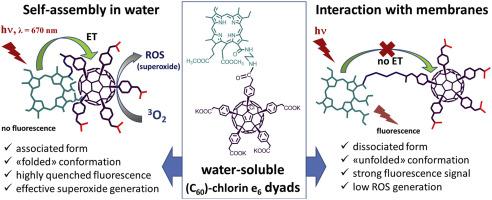Dyes and Pigments ( IF 4.5 ) Pub Date : 2020-04-06 , DOI: 10.1016/j.dyepig.2020.108411 A.Yu. Rybkin , A.Yu. Belik , N.S. Goryachev , P.A. Mikhaylov , O.A. Kraevaya , N.V. Filatova , I.I. Parkhomenko , A.S. Peregudov , A.A. Terent'ev , E.A. Larkina , A.F. Mironov , P.A. Troshin , A.I. Kotelnikov

|
The synthesis of water-soluble dyads PFD-Chl(1), PFD-Chl(Zn) and PFD-Chl(2) based on a polyanionic fullerene[60] derivative PFD covalently linked to chlorin e6 was described. Photophysical properties, generation of superoxide and singlet oxygen in water and liposomes, and photodynamic activity on HeLa cancer cells of obtained dyads were analyzed. The significant influence of linker length between fullerene[60] core and dye, presence of metal (Zn) atom in chlorin moiety on photophysical properties, and photodynamic activity of the dyads was demonstrated. All dyads exhibit quenching of chlorin fluorescence by 7–120 times due to the electron transfer from the dye to fullerene and they formed nanoassociates in aqueous solutions with an effective radius in the range of 30–500 nm due to their pronounced amphiphilic properties. Such nanoassociates were able to effectively interact with membranes of liposomes, which led to a sharp increase of fluorescence signal. This effect could be applied for the design of various fullerene-based nanoscale switch-off systems. The dyad PFD-Chl(1) – with the shortest linker and metal-free dye – had the superoxide generation efficiency 5.6 and 3.4 times higher compared to free chlorin Се6 in water and liposomes, respectively, while its singlet oxygen generation was reduced. The phototoxicity of this dyad in HeLa cells was almost equal to that of the native chlorin, despite the reduction of singlet oxygen generation efficiency. Upon the incorporation of zinc atom into a chlorin moiety of this dyad, photodynamic activity and phototoxicity of PFD-Chl(Zn) dyad became negligible. The PFD-Chl(2) dyad – with the longest linker and metal-free chlorin – had about two times lower photodynamic activity and phototoxicity compared to Ce6 due to weak interaction between fullerene core and the dye. A significant increase of the type I pathway efficiency, demonstrated in the PFD-Chl(1) dyad, could be applied for the creation of photosensitizers, highly effective against hypoxic tumors. The demonstrated approach opens up vast opportunities for a directional design of highly efficient fullerene-based water-soluble photosensitizers for photodynamic therapy.
中文翻译:

水溶性富勒烯[60]-二氢卟酚e6双分子的自组装纳米结构:合成,光物理性质和光动力活性
基于与二氢卟酚e 6共价连接的聚阴离子富勒烯[60]衍生物PFD的水溶性二元组PFD-Chl(1),PFD-Chl(Zn)和PFD-Chl(2)的合成被描述。分析了光物理性质,在水和脂质体中超氧化物和单线态氧的生成以及对获得的二联体对HeLa癌细胞的光动力活性。富勒烯[60]核心和染料之间的连接子长度,二氢卟酚部分中金属(Zn)原子的存在对光物理性质和二倍体的光动力活性的显着影响。由于电子从染料到富勒烯的转移,所有二联体均显示出二氢卟酚荧光猝灭了7–120倍,并且由于其明显的两亲性质,它们在水溶液中形成了有效半径范围为30–500 nm的纳米缔合物。这种纳米缔合体能够与脂质体膜有效相互作用,从而导致荧光信号急剧增加。这种效果可以应用于各种基于富勒烯的纳米级关闭系统的设计。二元组PFD-Chl(1)–具有最短的连接基和无金属的染料–在水中和脂质体中的超氧化物生成效率分别比游离二氢卟吩Се6高5.6和3.4倍,而其单重态氧的生成减少。尽管降低了单线态氧的产生效率,但该二联体在HeLa细胞中的光毒性几乎与天然二氢卟酚相同。将锌原子结合到该二聚体的二氢卟酚部分后,PFD-Chl(Zn)二聚体的光动力活性和光毒性变得微不足道。在PFD-CHL(2)二分体-具有最长接头和不含金属的卟酚-相比具有约2倍降低光动力活性和光毒性的Ce6由于富勒烯核与染料之间的相互作用较弱。在PFD-Chl(1)二联体中证明,I型途径效率的显着提高可用于创建光敏剂,对缺氧肿瘤高度有效。证明的方法为高效的基于富勒烯的水溶性光敏剂的定向设计提供了广阔的机会,用于光动力疗法。



























 京公网安备 11010802027423号
京公网安备 11010802027423号